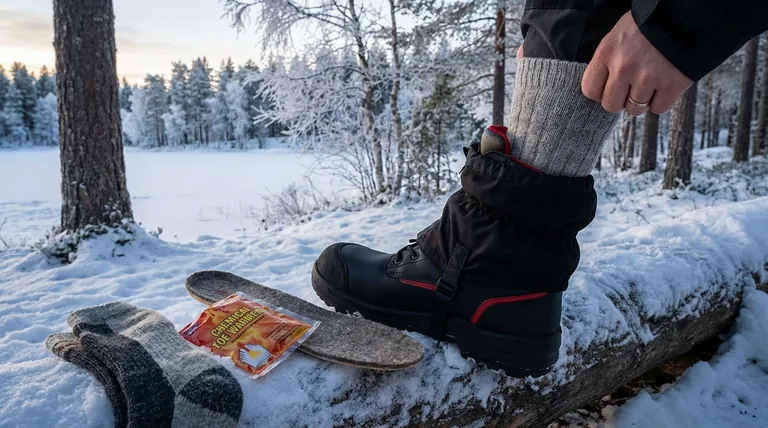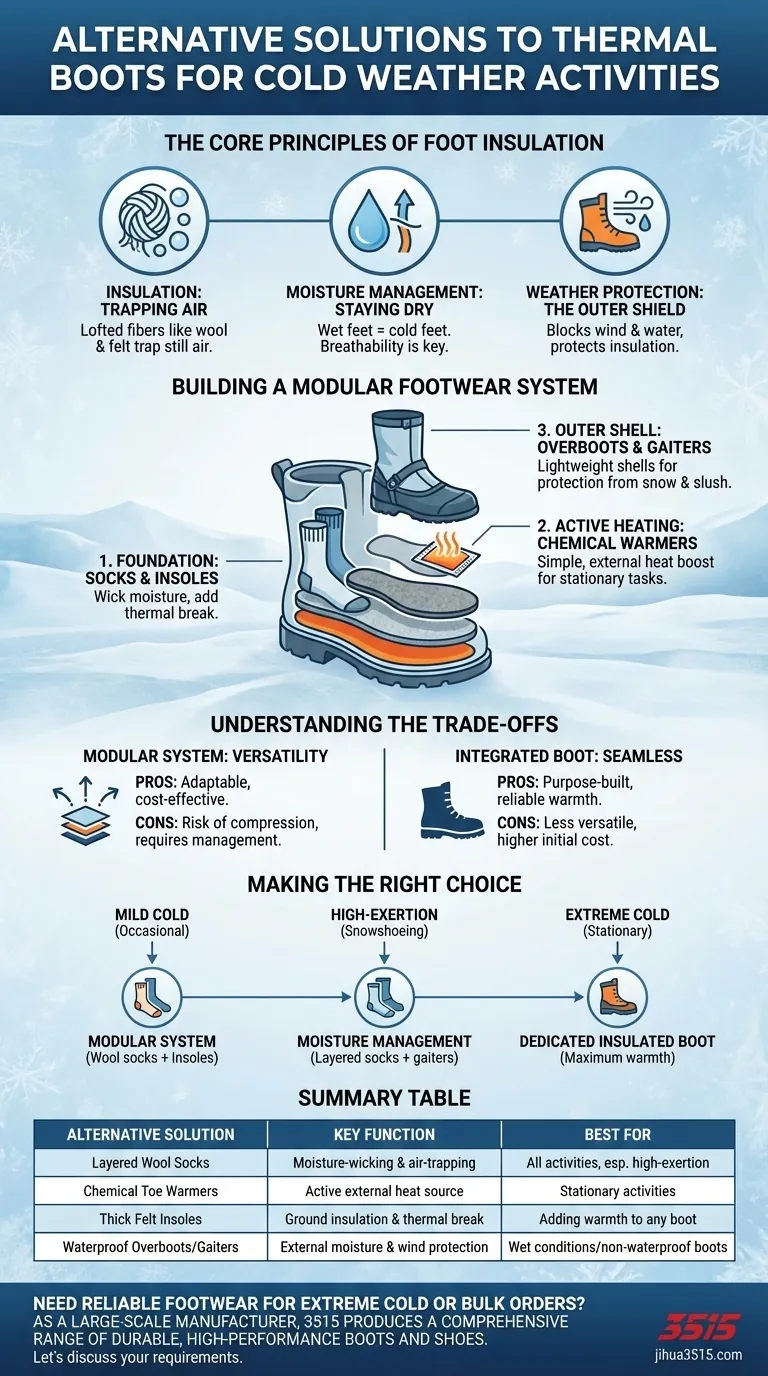For cold weather activities, several effective alternatives to dedicated thermal boots exist. These solutions focus on a modular layering system, using chemical toe warmers inside regular boots, layering multiple pairs of wool socks, adding thick felt insoles for ground insulation, and employing waterproof overboots or gaiters to keep your feet completely dry.
While a modular approach can provide significant warmth and versatility, it's crucial to understand that its effectiveness depends on proper layering and sizing. In extreme, prolonged cold, a purpose-built insulated boot often remains the most reliable and straightforward solution.

The Core Principles of Foot Insulation
To evaluate any solution, you must first understand the enemies of warm feet: heat loss to the ground (conduction), heat loss to the air (convection), and moisture from sweat or the environment. An effective system must combat all three.
Insulation: Trapping Air
The primary function of insulation is to trap a layer of still air around your foot. This trapped air is what keeps you warm, not the material itself.
Materials like wool and felt are excellent because their lofted fibers create thousands of tiny air pockets, slowing down heat transfer.
Moisture Management: Staying Dry
A wet foot is a cold foot. Water conducts heat away from your body 25 times faster than air.
Your system must keep external moisture (snow, slush) out while allowing internal moisture (sweat) to escape. This is why breathability is as important as waterproofing.
Weather Protection: The Outer Shield
The outermost layer of your system must block wind and water. This protects the insulating layers from getting compressed or wet, which would render them useless.
This is the role of a waterproof boot, an overboot, or a gaiter.
Building a Modular Footwear System
Instead of a single integrated boot, you can build a system by combining several components. This allows for greater adaptability across different conditions.
The Foundation: Socks and Insoles
Your sock choice is foundational. Merino wool socks are ideal because they insulate even when damp and effectively wick moisture away from your skin.
Layering a thin liner sock under a thicker wool sock can improve moisture management. For added warmth, a thick felt or wool insole creates a critical thermal break between your foot and the cold ground.
Active Heating: Chemical Warmers
Chemical toe warmers are a simple and effective way to add a significant heat boost.
These small, air-activated packets can be placed on top of your socks to provide several hours of continuous warmth, which is especially useful during stationary activities like ice fishing or winter camping.
The Outer Shell: Overboots and Gaiters
If your primary boots are not waterproof, overboots (also called "NEOS") are an excellent solution. They are lightweight, waterproof shells that fit over your existing footwear.
Gaiters are fabric guards that cover the gap between your pants and boots. They are essential for keeping deep snow from falling into your boots and melting, which would compromise your entire system.
Understanding the Trade-offs
A modular system offers versatility, but it comes with complexities that a dedicated insulated boot solves from the start.
The Risk of Compression
The biggest mistake is cramming too many layers into a boot that is too small.
This compresses the insulation, eliminating the trapped air pockets and reducing its effectiveness. It can also restrict blood flow, making your feet even colder. Your boots must be sized to accommodate the extra volume of thicker socks or insoles.
Integrated vs. Modular Performance
Dedicated thermal boots are an integrated system where insulation, waterproofing, and durability are designed to work together seamlessly.
A modular approach requires more knowledge and management. You must ensure each component works with the others, and it may not offer the same level of robust protection in severe, wet, or icy conditions.
Durability and Traction
Winter boots are built with durable materials and outsoles designed for traction on snow and ice.
A standard hiking boot, even when layered, may not have a sole compound that stays pliable in freezing temperatures, potentially leading to slips and falls.
Making the Right Choice for Your Activity
Your decision should be based on your specific activity, the expected conditions, and your budget.
- If your primary focus is occasional use in mild cold: A modular system using wool socks, insoles, and your existing waterproof boots is a cost-effective and versatile solution.
- If your primary focus is high-exertion activity (like snowshoeing): Prioritize moisture management with a layered sock system inside a breathable, waterproof boot, and add gaiters to keep snow out.
- If your primary focus is stationary activity in extreme cold (like ice fishing): A dedicated, highly-rated insulated winter boot is the safest and most reliable choice for maximum warmth.
Ultimately, choosing the right system ensures your comfort and safety, allowing you to focus on the activity at hand.
Summary Table:
| Alternative Solution | Key Function | Best For |
|---|---|---|
| Layered Wool Socks | Moisture-wicking & air-trapping insulation | All activities, especially high-exertion |
| Chemical Toe Warmers | Active, external heat source | Stationary activities (e.g., ice fishing) |
| Thick Felt Insoles | Ground insulation & thermal break | Adding warmth to any existing boot |
| Waterproof Overboots/Gaiters | External moisture & wind protection | Wet conditions or non-waterproof boots |
Need reliable footwear for extreme cold or bulk orders?
As a large-scale manufacturer, 3515 produces a comprehensive range of durable, high-performance boots and shoes for distributors, brand owners, and bulk clients. Whether you need purpose-built insulated boots for maximum warmth or versatile footwear perfect for a modular layering system, our production capabilities cover all types of shoes and boots to meet your specific needs and ensure your customers' comfort and safety.
Let's discuss your requirements → Contact our team today
Visual Guide

Related Products
- Premium Wholesale Waterproof Safety Boots High Performance Protection for Industrial Markets
- Customizable Anti-Smash Safety Boots for Wholesale & Private Label Manufacturing
- Custom Wholesale Leather Safety Boots Direct Factory Manufacturing
- High Performance Fire-Retardant Waterproof Safety Boots
- Premium Grain Leather Safety Boots for Bulk Supply
People Also Ask
- What are some examples of footwear requirements in different work settings? Ensure Safety and Compliance
- How do safety shoes protect you? A Guide to Essential Footwear Safety Features
- What are some real-world examples of safety footwear preventing injuries? Protect Your Workforce Effectively
- What is a safety-toe in a boot? Your Guide to Choosing the Right Protection
- What is the primary purpose of safety shoes? Your Ultimate Guide to Workplace Foot Protection



















